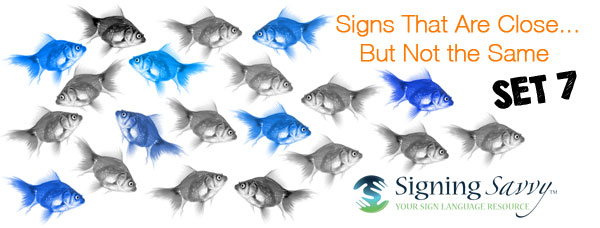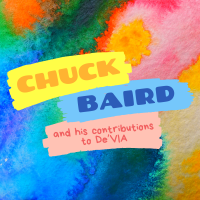
Signs That Are Close... But Not the Same - Set 7
This article is part of our “Signs That Are Close... But Not the Same” series, which highlights signs that look similar, but have different meanings.
The ASL signs shown below look similar, but are not the same. There are many ASL signs that when produced look similar, but in fact have a completely different meaning. Below you will find examples of such signs. Watch closely to see if you can see the differences. In addition, watch my eyebrows, look to see when I tilt my head or lean my body in a certain way, even what my mouth is doing. These nuances are called inflections and trust me, inflections matter.
1. Brain vs. Think
It is easy to see the difference between BRAIN and THINK since they use different handshapes - BRAIN uses the X-hand to tap twice on the side of your head, while THINK uses the 1-hand to make a swift movement to point at your head. However, remembering which is signed which way, can be a challenge! For BRAIN you tap where your brain is, confirming it is in there, while you point to where you’re thinking takes place just as swiftly as you might get an idea.
 |
2. Color vs. Friendly
COLOR and FRIENDLY both use the open 5-hand. COLOR is signed with one 5-hand at the chin with your fingers making a wiggling motion. Think about your wiggling fingers representing the colors in a rainbow when signing COLOR. FRIENDLY is signed with two 5-hands with wiggling fingers moving up and away from the face; the movement suggests a generous smile that accompanies a friendly person.
 |
3. Oh I See vs. Yellow
OH I SEE and YELLOW both use a single, dominant Y-hand. To sign OH I SEE, the palm is out and makes an up and down movement. OH I SEE is like signing THAT multiple times because the meaning is that you are emphasizing you see or understand “that.” YELLOW is signed like many of the other color signs, such as BLUE, GREEN, and PURPLE, with the palm facing more towards the body and making a twisting motion.
 |
4. History vs. Hard of Hearing
The dominate H-hand is used when signing both HISTORY and HARD OF HEARING. To sign HISTORY, the H-hand bounces up and down slightly two times. You can remember HISTORY moves twice in the same spot by thinking of history being cyclical over time and repeating itself.
HARD OF HEARING also has the H-hand move two times, but it moves down from your non-dominant side and then shifts over to move down again closer to your dominant side. This movement from your non-dominant to dominant side is also similar to how you move when fingerspelling multiple words and the sign for HARD OF HEARING uses two movements with the H-hand as a representation of the “H” in hard and then the “H” in hearing.
 |
5. Fancy vs. Fine
FINE has the thumb of the dominant open 5-hand tap the chest, while FANCY has the thumb of the dominant open 5-hand stroke the chest and come out in a repeated motion. The gesture for FINE suggests the feeling of doing fine and the motion made when signing FANCY is an exaggerated version of signing FINE, since when something is FANCY, it is much more than just FINE.
 |
How can I figure out the difference between signs on my own?
If you see two signs that look close, but not the same, and you’re not sure, you may use Signing Savvy features to help you figure out the difference. All of our signs have sign descriptions and memory aids that members may access. Reading the sign description and memory aids for the signs will help you figure out the small differences between them that your eyes don’t catch at first. We also recommend using the pause and slow motion feature to slow down the video, so you may take a closer look. These features are available to Signing Savvy members.
Take a look, it's in a book!
These examples are aligned with the Visual Discrimination section of Lesson 9 (page 109) from Lessons and Activities in American Sign Language by Brenda E. Cartwright and Suellen J. Bahleda. Check out the book for more ASL Activities and watch for more examples from this series: “Signs That Are Close... But Not the Same.”
Resources
Signing Savvy is a participant in the Amazon Services LLC Associates Program, an affiliate advertising program designed to provide a means for sites to earn advertising fees by advertising and linking signingsavvy.com to Amazon properties. That means Signing Savvy may contain affiliate links. If you make a purchase after clicking on an affiliate link, your cost will be exactly the same regardless, but Signing Savvy will automatically receive a small commission. Your support is greatly appreciated and helps us continue to improve Signing Savvy!
 Brenda Cartwright is a Coda, seasoned interpreter, a master teacher, well known presenter, and author of several best selling sign language and interpreting textbooks from the RID Press. For 35 years Brenda was the Chair of the Sign Language Interpreter Program at Lansing Community College in Lansing, Michigan.
Brenda Cartwright is a Coda, seasoned interpreter, a master teacher, well known presenter, and author of several best selling sign language and interpreting textbooks from the RID Press. For 35 years Brenda was the Chair of the Sign Language Interpreter Program at Lansing Community College in Lansing, Michigan. Signs That Are Close... But Not the Same - Set 1
Signs That Are Close... But Not the Same - Set 1 Signs That Are Close... But Not the Same - Set 2
Signs That Are Close... But Not the Same - Set 2 Signs That Are Close... But Not the Same - Set 3
Signs That Are Close... But Not the Same - Set 3 Signs That Are Close... But Not the Same - Set 4
Signs That Are Close... But Not the Same - Set 4 Signs That Are Close... But Not the Same - Set 5
Signs That Are Close... But Not the Same - Set 5 Signs That Are Close... But Not the Same - Set 6
Signs That Are Close... But Not the Same - Set 6







Savvy User GeriTuesday, November 20, 2018
This is dialect for one area. Some dialectual differences have some of these signs not even close. Example: "h" hand comng out from chest for "histry" i not near "Hard of hearing" sign.